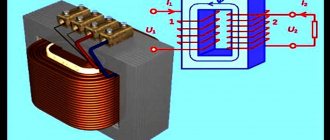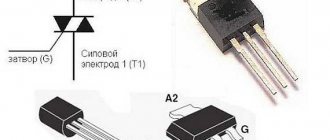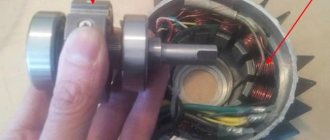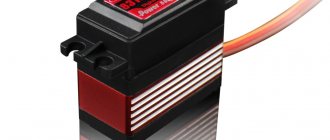Thermostats
Are you too hot? Then you'll want to cool down. Are you too cold? So you need to warm up. Our bodies are amazing self-regulating machines that can constantly adapt to keep our temperature within 37°C. But the rest of the world doesn't work that way. If we want our homes to maintain a more or less constant temperature, we must constantly turn the heaters on and off - or, alternatively, rely on smart devices called thermostats to do the job for us. What are they and how do they work? Let's take a look inside!
In the photo: a simple mechanical thermostat installed in control and automation cabinets to control the temperature of air heating from OSHA heaters. It shows the current temperature in degrees Celsius. Once you've set the temperature, the thermostat should turn the heat on and off as needed to keep the cabinet at the desired temperature. In practice, such a thermostat does not turn on and off at one temperature, but switches between a small range of temperatures on either side of the value you set.
What is a thermostat?
Surely you have already seen a thermostat somewhere, placed on a wall or on household appliances to control the heating system. And although the device itself indicates the temperature, it is not a thermometer. This is called thermostat , a modern word based on two ancient Greeks: thermo- (meaning heat) and statos (meaning standing and related to words like stasis, status quo, and static, meaning to remain the same). Just from the name we can say that a thermostat is something that “keeps the heat the same”: when the temperature of the controlled heating or process is too low, the thermostat turns on the heating, so the temperature rises quickly; As soon as the temperature reaches the level we set, the thermostat turns off the heating. To control cooling, the thermostat works in the same way: as long as the temperature is higher than the set temperature, the coolers work, as soon as the limit value is reached, they turn off.
Let's just clarify the difference: a thermometer is something that measures temperature; The thermostat is what tries to maintain the temperature (keep it about the same).
In the photo: electronic thermostat STC-1000 with digital temperature display. This one works a little differently than the mechanical one in the top photo. The display is part of the programmer. Temperature data comes from a thermocouple, which continuously measures the temperature in the controlled environment, and then the thermostat turns heating or cooling on and off to keep it within 1°C of your set temperature.
Types of thermostats with temperature sensor
A thermostat is a sensor that records temperature readings and allows you to maintain it at a specific level. The models differ in several ways, including:
Thermostat temperature control method
Depending on the equipment for which thermostats are used, sensors measure the temperature of air, floor or water. There are also combined units that take into account different types of meters.
Combination thermostat monitor
2 Type of thermostat installation
When choosing a thermostat for a washing machine, boiler or refrigerator, it is important to consider that installation may differ depending on the type of equipment. Temperature sensors can be:
- Invoices.
- Submersible.
- Internal.
- External.
Thanks to what the thermostat does, the operation of autonomous devices and entire systems becomes rational and safe. In order for the equipment to perform its purpose without failure, it is important to install it correctly.
Washing machine thermostat
It is better to entrust the installation of the thermostat to specialists. Replacing a damaged device or installing a new device must be carried out in accordance with the manufacturer's recommendations. Otherwise, you may damage not only the device, but also the system as a whole.
Thermostat materials
A modern thermostat is a device for measuring and controlling temperature in various environments. Therefore, sensors are made from various materials. Models can be constructed from:
- Durable plastic.
- Bimetals.
Thermostat operating principle
Today, sensors of different types of action are relevant:
- Mechanical . Data is read thanks to the expansion of bimetal plates.
- Electronic . Temperature control is carried out using built-in thermometers.
- Electromechanical . The work is based on bimetallic parts.
Electronic thermostat
Bimetallic thermostats
A traditional thermostat consists of two parts made of different metals bonded together to form what is called a bimetallic strip (or bimetallic strip). The plate acts as a bridge in the electrical circuit connected to your heating system. Usually the "bridge is not working", the plate passes electricity through the circuit, and the heating is turned on. When the plate heats up, one of the metals expands more than the other, so the whole strip bends very slightly. Eventually it bends so much that it breaks the chain. “The bridge is established,” the electricity instantly turns off, the heating turns off, and the temperature begins to drop.
But what happens next? As it cools, the plate also cools and returns to its original shape. Sooner or later it gets plugged back into the circuit and causes the electricity to flow again and the heating to turn on again. By adjusting the temperature dial, you change the temperature at which the circuit turns on and off. Because the metal strip takes a while to expand and contract, the heat doesn't turn on and off constantly every few seconds, which would be pointless (and quite annoying). For example, when heating your home, depending on how well insulated your home is and how cold it is outside, it may take an hour or more for the thermostat to come back on after it's turned off. And the built-in thermostats in OSHA control cabinet heaters, which serve to maintain the heater temperature in a safe range, can turn on more often.
Types of thermostats
Capacitor - what is it for, device and principle of operation
Devices designed to regulate temperature can be classified on various grounds. Products are produced designed for different types of installation: on the wall or on a DIN rail. The supported measurement range and number of channels vary. However, first of all, they differ in structure, depending on what mechanical components and electronic components are involved in them.
Mechanical thermostats
These are the simplest products, devoid of electronic “filling”; most often they are used to control the temperature of residential premises. Their work is based on the ability of some materials to change their characteristics under the influence of changing temperatures. The frames are set by rotating the wheel. When they are exceeded, a short circuit or break in the electrical circuit occurs, leading to the connection of additional heating elements or the cutting off of existing ones.
The advantages of this design are reliability, durability, ease of control, ability to operate at sub-zero temperatures, and resistance to power surges. The main disadvantage is the probability of error, in some cases quite significant (up to 3 degrees). In addition, the products cannot be called silent: when triggered, they make clicking sounds.
Mechanical regulator
Bimetallic plates
When heated, such a plate is deformed and opens the closed contacts. As a result, current stops flowing to the heating element of the device. As it cools, the plate returns to its previous position and the contacts are connected again. Then electricity is again supplied to the corresponding element, which entails heating. This design is built into electric kettles, stoves, and irons.
Bimetallic strip operation
Gas-filled sensors
Gas thermostats include a gas-filled pipe and contact elements. When placed in a liquid, the gas expands and causes the contact to close. Opening occurs when the liquid medium cools. The design is installed in water heaters and oil heating appliances.
Important! The advantages of this and the previous types are automatic regulation and budget price, the disadvantage is the lack of space for variable flexible settings, which limits the scope of application.
Wax thermostats
These devices consist of a hermetically sealed chamber equipped with a wax stopper and a metal rod. When heated, the melting wax displaces the rod outward, and the latter initiates changes in the electrical circuit. Such designs are widely used in the automotive industry, as well as in the design of mixers.
Electronic thermostats
They are used in various types of climate control systems and in heated floor structures. They include a temperature sensor, an electronic key and a control unit that generates commands to connect and turn off the heating elements. The devices are equipped with an electronic display that displays temperature data. They come with closed and open logic. Flexibility of settings and advanced control capabilities are inherent only in the second type; such products are produced with push-button or touch controls.
Electronic device
Dual zone thermostats
A two-zone thermostat provides the ability to control two heating systems in parallel, for example, a kitchen and a living room. Some models are limited to the ability to select from several preset programs, while others allow you to independently set parameters. Thermal sensors should be placed in places where moisture and direct rays of the sun do not penetrate.
How does a bimetallic thermostat turn on and off?
- The external dial allows you to set the temperature at which the thermostat turns on and off.
- The dial is connected by a circuit to a temperature sensor (a bimetallic strip, shown here in red and blue), which turns the electrical circuit on and off by bending it.
- A bimetallic (“two-metal”) plate consists of two separate strips of metal held together: a piece of brass (blue) screwed to an iron piece (red).
- When heated, iron expands less than brass, so the bimetallic strip bends inward as the temperature rises.
- The bimetallic strip forms part of an electrical circuit (gray path). When the strip has cooled, it is straight, so it acts as a bridge through which electricity can flow. The circuit and heating are on. When the strip is hotter, it bends and breaks the circuit, so electricity cannot flow. The circuit is now disconnected.
Classification of thermostats
The operating principle of all devices that regulate temperature is the same, but there are many types of thermostats, and they differ in different characteristics.
By purpose:
- indoor
- weather
By installation method:
- wall
- wall-mounted
- DIN rail mounted
By functionality:
- central regulation
- wireless regulation
By control method:
- mechanical
- electromechanical
- digital (electronic)
Thermostats also differ in technical properties:
Temperature measurement range. Different models of thermostats, depending on the modification, maintain temperatures from -60 to 1200 °C.
Number of channels:
- single-channel. They are used to automatically adjust and maintain the temperature of an object at a specified level. Differ in smaller size and weight
- multichannel. A series of standard temperature sensors are produced to record temperature. They are used in factories, laboratories, and also in the national economy.
Dimensions:
- compact
- big
- large
Application of thermostats and sensors
Programmable thermostats can be installed in residential and industrial premises. In general, the following groups of thermostats can be distinguished:
- Taking into account and controlling the air temperature in a specific area of the room. These devices belong to the category of room regulators. There are analog and digital.
- Controllers for underfloor heating take into account and maintain the temperature of certain objects.
- Weather thermostats that take into account the outside air temperature.
Regulators that are used in industrial premises are of two types:
- industrial spatial. These devices include analog wall regulators that have increased protection
- industrial with separate sensors. These are analog devices with external sensors that can be wall-mounted or mounted on a special rail
Sensors can be installed on the walls or in the floor of the house, depending on their type and purpose. Built-in devices are mounted in a mounting box directly into the wall, and surface-mounted devices are simply attached to the wall.
There are also several types of sensors according to their purpose:
- floor temperature sensor
- air temperature sensor
- infrared sensor for floor and air
A sensor that measures air temperature is often placed on the body of the thermostat. Thermostats with infrared sensors can be used to control the entire heating system. These sensors are perfect for installation in bathrooms, showers, saunas and other rooms with high humidity. The temperature controller itself must be placed in a dry place; it can be damaged from excess moisture. True, there are models with increased tightness, and their installation in the bathroom is not dangerous in any way for them.
Regulators for heated floors differ in their internal structure, so there are the following:
- digital
- analog
Digital devices have good resistance to various types of interference, therefore they eliminate data distortion and guarantee greater accuracy than analogue ones.
Features of the functionality of electric temperature controllers:
- wireless control (remote). It is recommended to use it for additional installation of heating elements and reconstruction, when it is impossible or quite difficult to perform classical adjustment. Remote control eliminates additional construction and repair work during electrical installation (for example, installation of cable wiring)
- programming devices. The central (classical) device allows you to regulate the temperature of an entire large object from one point. To program the controller, a computer or control devices are used. Control is also carried out using a telephone modem
Gas-filled bellows
The problem with bimetallic strips is that they take a long time to heat up or cool down, so they don't respond quickly to temperature changes. An alternative thermostat design detects temperature changes more quickly by using a pair of metal discs with a gas-filled bellows between them. The discs have a large surface area so they respond quickly to heat, and they are corrugated (they have ridges on them) which makes them resilient and flexible. When the controlled medium heats up, the gas in the bellows expands and pushes the discs apart. An internal dial presses a microswitch in the center of the thermostat, turning off the electrical circuit (and the heating). As the room cools, the gas in the bellows is compressed and the metal discs are compressed again. The internal disk moves away from the microswitch, turning on the electrical circuit and turning the heating back on. You can also find thermostats with bellows in other applications (such as older cars), and instead of gas, they are sometimes filled with a volatile (low-boiling) liquid such as dilute alcohol; the exact chemical inside depends on the temperature range in which they must operate.
Photo: The thermostat regulates temperature using a pair of metal discs separated by gas-filled bellows that press a microswitch. As the temperature dial is turned, the dials move closer or further from the microswitch in the center. This means that the gas bellows must more or less expand to turn the electricity on or off, effectively raising the temperature at which the switch operates (and the room temperature).
Scope of application of the thermostat - what does it affect?
What a thermostat does depends on its application. This can also be said about the principle of its operation. If we talk about where sensors are used, we can highlight:
- Water heaters.
- Washing machines.
- Refrigerators.
- Gas boilers.
- Faucets.
- Warm floor.
You can answer what the thermostat is responsible for, regardless of where it is used - fixing and controlling the temperature. It is like a trigger mechanism that gives commands to other systems.
Thermostat with socket for household appliances
Today, the scope of application of thermostats is very wide; they are used for household appliances, heating systems and vehicles. Previously, sensors were used mainly for chemical experiments and physical research
Wax thermostats
To summarize what we have already determined, you can see that all mechanical thermostats (all non-electronic ones) use substances that change size or shape as temperature increases. Thus, bit-metal thermostats rely on the expansion of metals as they heat up, while gas bellows work by expanding gases. Some thermostats go further and use a change in the state of a substance from liquid to gas. Wax thermostats are probably the most common example, and you'll find them in home radiator valves, car engines, and shower faucets. They use a small plug of wax inside a sealed chamber. When the temperature changes, the wax melts (changes state from solid to liquid), expands greatly and pushes a rod out of the chamber, which turns something on or off (controlling the engine cooling system in a car or adjusting the mixture of hot and cold water in the shower so that the body does not boil , like a lobster). Wax thermostats tend to be more reliable and durable under extreme conditions inside a car engine.
Photo 1: How a wax thermostat works. The wax (blue) is contained within a sealed chamber (gray) that contains a metal needle (silver). As the temperature rises, the wax melts, expands, and pushes the needle out of the chamber (yellow arrows). The rising arrow turns on or off any device controlled by the thermostat. A spring (not shown) pulls the entire mechanism again when the temperature drops. Photo 2: Here is the inside of a shower control with faucet, showing what a wax thermostat actually looks like. The little black cylinder in the middle is a wax thermostat that moves in and out to regulate the flow of hot and cold water, keeping the mixed water (coming from the shower head) at a more or less constant temperature. This photo shows the spring that pulls the thermostat back when the temperature drops and the wax thermostat contracts again.
Thermostatic radiator valves
Pictured: This thermostatic valve regulates the flow of hot water through the radiator, preventing the room from overheating. If the room gets too hot, a wax thermostat is activated, which activates a valve, cutting off the flow of water through the radiator until the temperature drops again.
Temperature valves fitted to central heating radiators usually use wax thermostats. When radiators heat up to the level you set, the wax valves expand and reduce the flow of water through the radiator until the temperature drops again. When combined with room thermostats, these valves can protect your home from overheating—and are a good way to both save energy and money, and do your part to combat global warming.











